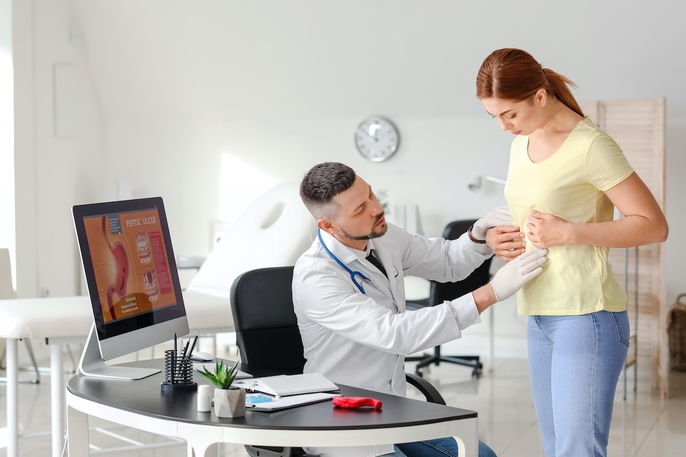Polyps in the stomach are masses of cells that can arise due to excessive growth of stomach lining cells. Most of the time, they do not cause any symptoms and are only discovered during routine examinations. However, when they are large, they can lead to wounds or ulcers, resulting in symptoms such as abdominal pain, nausea or bloody stools.
Stomach polyps, also called gastric polyps, can be caused by inflammation in the stomach, such as gastritis, or by frequent use of antacid medications. They are more common in people over 50 years of age.
The treatment of polyps in the stomach is carried out by a gastroenterologist, with surgical removal of the polyps to avoid complications, such as bleeding, infections or obstruction of the stomach.

Main symptoms
The most common symptoms of polyps in the stomach are:
- Heartburn
- Gastroesophageal reflux
- Abdominal pain or discomfort
- Indigestion
- Feeling of a full stomach
- Increased gas production
- Nausea
- Excessive tiredness
- Blood in the stool or dark stools
- Vomiting with blood
- Decrease in blood pressure
Generally, polyps in the stomach cause symptoms when the polyp is very large. These can lead to wounds, ulcers, bleeding or even stomach obstruction.
It is important to consult a general practitioner or gastroenterologist in the presence of symptoms so that an endoscopy can be ordered to assess polyp and carry out treatment as needed
Can stomach polyps turn into cancer?
In most cases, polyps in the stomach are benign and have a low probability of turning into cancer, however in the case of adenomatous polyps or familial adenomatous polyposis, there is a greater risk of turning into cancer.
Confirming a diagnosis
Polyps in the stomach are diagnosed though an endoscopy, which looks at the inside of the stomach, making it possible to visualize the presence of polyps.
If a polyp is identified, a biopsy is performed in which a small portion of the polyp is collected for analysis in the laboratory. This helps to identify the type of polyp is defined.
Types of stomach polyps
Polyps in the stomach can be classified depending to the characteristics of the cells, the main ones being:
- Fundic gland polyp: this is the most common type of gastric polyp that can be present in the bottom of the stomach or in its upper portion. They are usually found in routine endoscopic exams, and rarely turn into cancer;
- Hyperplastic polyp: this type of gastric polyp usually spreads throughout the stomach and near stomach ulcers. Despite having a lower risk of turning into cancer, hyperplastic polyps can lead to the appearance of cancer in the stomach wall, especially in cases of chronic gastritis;
- Adenomatous polyp: these are normally found near the bottom of the stomach, and are usually the beginning of a stomach cancer. This type of polyp should be removed by the doctor during endoscopy, as it can also increase the risk of developing cancer in the intestine or other parts of the body.
The type of gastric polyp is defined through the results of the biopsy or surgical removal of the polyp during endoscopy and analysis of the cells in the laboratory.
Also recommended: Polyps in Colon: Symptoms, Diagnosis, Causes & Treatment tuasaude.com/en/polyps-in-colonPossible causes
The causes of stomach polyps are not yet completely understood, however, it is believed to be related to chronic irritation or inflammation of the stomach, resulting in excessive proliferation of the cells lining the stomach.
Some factors can contribute to the development of stomach polyps, such as:
- Family history of familial adenomatous polyposis;
- Gastritis;
- Gastroesophageal reflux;
- H. pylori infections in the stomach;
- Esophagitis;
- Chronic use of proton pump inhibitor medications, such as omeprazole or lansoprazole, for example.
Furthermore, age can also increase the risk for polyps in the stomach, which are more common after the age of 50.
Treatment options
The treatment of gastric polyps is carried out as directed by a gastroenterologist and depends on the type, size, location, quantity, symptoms and the probability of the polyp becoming cancer.
The main treatments recommended by the gastroenterologist are:
- Periodic monitoring, to evaluate the growth of polyps through endoscopy, which can be carried out every 3 to 6 months in the case of H. pylori infection or every 12 months, in the case of polyps without dysplasia
- Removal of polyps during endoscopy, when they are larger than 5 mm, are of the adenomatous type, or if there is a history of familial adenomatous polyposis
- Use of proton pump inhibitor medications for 4 to 8 weeks after biopsy or removal of polyps by endoscopy;
- Use of antibiotics, such as clarithromycin, amoxicillin or metronidazole, to treat H. pylori.
Furthermore, if polyps in the stomach have occurred due to chronic use of proton pump inhibitor medications, the doctor may discontinue their use and repeat the endoscopy in 12 months.
Stomach polyp diet
The stomach polyp diet is generally recommended by a doctor to help treat gastritis, stomach ulcers, gastroesophageal reflux or H. pylori infection. This diet can help to relieve symptoms of heartburn, indigestion or a feeling of a full stomach. It should be done preferably as directed by a registered dietitian.
Therefore, you are advised to consume fruits, cooked vegetables, grains, light dairy products, bread, and lean meats. You should avoid very hot foods, alcoholic drinks, soft drinks, sandwiches, fast food, fried foods and sweets in general. Learn more about the gastritis diet and how to get started.






























